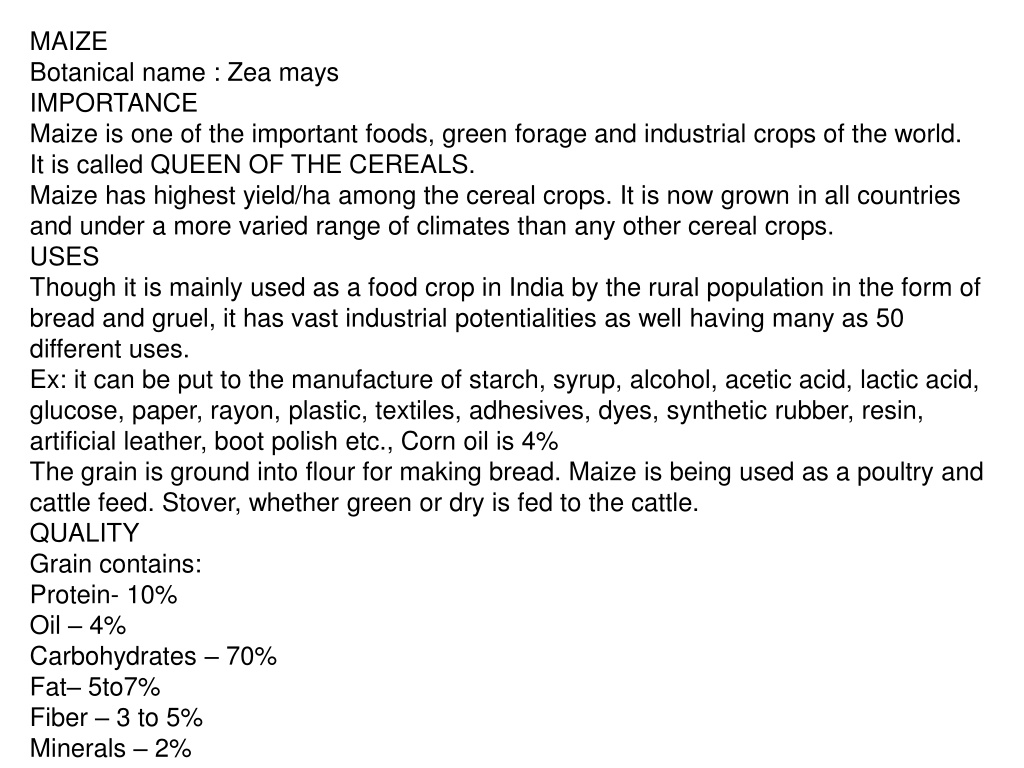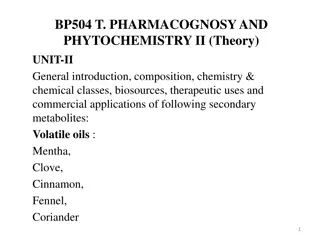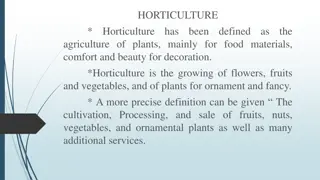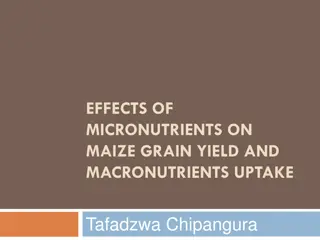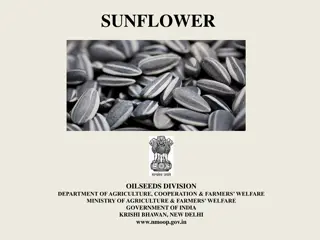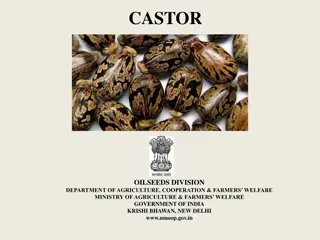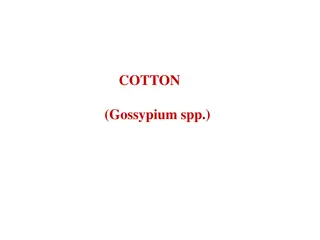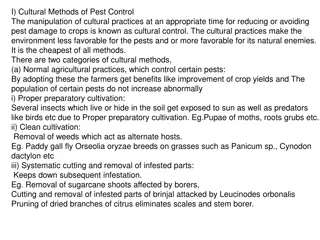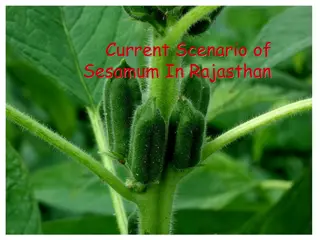Understanding the Importance and Cultivation of Maize Worldwide
Maize, known as the "Queen of the Cereals," is a versatile crop with diverse uses ranging from food to industrial products. Originating in South America, maize is now grown globally, including in India, where it plays a significant role in agriculture. This article explores the botanical details, distribution, cultivation requirements, and economic importance of maize. Different aspects such as soil preferences, climatic needs, and seasonal considerations are also discussed, providing a comprehensive overview of this vital crop.
Download Presentation

Please find below an Image/Link to download the presentation.
The content on the website is provided AS IS for your information and personal use only. It may not be sold, licensed, or shared on other websites without obtaining consent from the author. Download presentation by click this link. If you encounter any issues during the download, it is possible that the publisher has removed the file from their server.
E N D
Presentation Transcript
MAIZE Botanical name : Zea mays IMPORTANCE Maize is one of the important foods, green forage and industrial crops of the world. It is called QUEEN OF THE CEREALS. Maize has highest yield/ha among the cereal crops. It is now grown in all countries and under a more varied range of climates than any other cereal crops. USES Though it is mainly used as a food crop in India by the rural population in the form of bread and gruel, it has vast industrial potentialities as well having many as 50 different uses. Ex: it can be put to the manufacture of starch, syrup, alcohol, acetic acid, lactic acid, glucose, paper, rayon, plastic, textiles, adhesives, dyes, synthetic rubber, resin, artificial leather, boot polish etc., Corn oil is 4% The grain is ground into flour for making bread. Maize is being used as a poultry and cattle feed. Stover, whether green or dry is fed to the cattle. QUALITY Grain contains: Protein- 10% Oil 4% Carbohydrates 70% Fat 5to7% Fiber 3 to 5% Minerals 2%
ORIGIN AND DISTRIBUTION Origin of maize plant is still not definitely known, probably because of its wild relatives having become extinct during the long period of cultivation. The wild relative of maize is Teosinte. Geographical origin of maize is said to be somewhere in tropical zone of South America, probably in the South western part of the Amazon river basin. it is introduced to india by east india company AREA AND PRODUCTION Among cereals maize crop occupies 3rd place in the world after wheat and rice. America ranks first in productivity followed by Europe. Maize is consumed primarily as a source of human food. India cultivates 5.4% of the total area and provides 1.7% of the total production of maize in the world. In India, area - 6.30 m. ha in A.P, area - 396000 ha production - 10.85 m. tonnes. production - 1084000 tonnes productivity - 1720 kg/ha. productivity - 2740 kg/ha
In India, UP ranks first in area production while the productivity is highest in Karnataka. Punjab ranks fourth position. In AP, it is intensively grown in North and South Telangana particularly Karimnagar, Medak, Nizamabad, Warangal and Adilabad districts. CLIMATIC REQUIREMENTS Maize is a tropical plant which prefers warm humid weather. It is grown under extremely divergent climatic conditions in different parts of the world ranging from tropical to temperate regions. It is a short day plant and is very sensitive to moisture stress it is grown in temperatures ranging from 15 to 45 C and optimum temp is 32 600 mm rainfall with even distribution is sufficient for good cultivation. SOILS : Maize can be grown on a variety of soils, but it grows best on well darined soils which are rendered fertile by adequate supply of manures. Best soils are --- Deept dark silt loams Opt PH --- 6.5-7.5 SEASONS : Kharif season --- with onset of monsoon i.e in June or July and harvested in late September or Octover. Crop--- Grown from Oct to January as irrigated one. Sowing maize at about 5 days before onset of monsoon and providing irrigation, results in good plant stand and highest grain yields.
ON [LAND PREPERATION] At least 2-3 shallow tillage operations during summer season are essential in all maize growing areas. Deep ploughing is also helpful to control weeds and for efficient moisture conservation similarly bed and furrow or ridge and furrow systems are suitable in semi arid and sub humid regions. In high rainfall regions ill drainage reduces the yields. Therefore in Dehradun valley the system of ZINGG terracing has been found suitable. ZINGG TERRACING In this method, maize is grown in the upper 75/ area of the plot which is kept slopy to provide quick drainage and rice is grown in the remaining 25/ area which is leveled to accommodate the run off from the upper portion of the plant. VARIETIES : DHM-101, 103, 1 Rohini, Ashwini } synthetics Trishulatha --- 3 way cross Arsha & Varun ---- composites SEEDS AND SOWING : Yield of maize remains the same over a wide range of pant po;ulations. On an average 60000-80000 plants/ha is optimum for good yields. For pure crop --- 20-25 kg seed/ha [60x25 cm or 75 x20 cm] For fodder maize --- 40-50 kg/ha
Method of sowing : It is desirable to dibble the maize seed by the side of the ridges at a distance of 1/3 from the top of the ridge. Dibble seed 2-3 cm deep and should not be more than 5 cm. Ridge sowing facilitated irrigation as well as drainage. INTERCULTIVATION : Weed contrl : Timely weed control is important. Proper and timely inter cultivation helps in aeration by loosening the surface soil and assures good yields. Weeds --- grasses --- cynodon dactylon, Echinoclhloa colonum Sedges --- cyperus iria, eleusine indica Maize needs two intercultivations and two handweedings. The first 6-7 weeks of maize growth is the most critical period for weeds. Pre emergence application of Simazine [Tafazine] or Atrazine [Atrafaf] at 2 kg/ha is found to control weeds effectively and it should be sprayed 2 or 3 DAs, wetting the entire surface uniformly. Later the soil should not be disturbed for 4-5 weeks after application of the herbicide. For post emergence application of 2,4 DEE at 1 1 2 -2 kg/ha at any time when maize is about 20 cm height.
WATER MANAGEMENT : Maize is sensitive to both drought and water logging. Proper water management is a must for increasing yields. Maize uses water efficiently. It s water requirement is influenced by growthstages,season,weather,Soil conditions The optimum available soil moisture for maize crop is 80 or 75/.. The frequency of irrigation will be once in 6-10 days in a medium texture soil the total water requirement vary from 530 mm to 800 mm depending upon the season and rainfall received during the crop growth period. The most critical period for moisture stress is flowering stage [i.e. tasselling and silking] Upto 40 DAS, the crop is more sensitive to excess moisture and from preflowering to maturity, it is more sensitive to drought. If soil moisture stress occurs during early vegetative stage --- then flowering is delayed. Drought at flowering stage --- reduces yield and at later stages affect size and popping quality in popcorn Furrow method of irrigation is both efficient and convenient for maize crop.
precautions : 1. Apply water evenly and uniformly while irrigating the maize crop. 2. Drain out excess water promptly. 3. Open the filed drains at even if to avoid the chances of damage due to excess water or rain. 4. The crop should be irrigated immediately if the leaves roll or wilt MANURES AND FERTILISERS : As in other crops, a balanced and integrated nutrient management plays a pivotal role in maize cultivation. At maturity 1 2 of the dry matter production is accounted for starch in the grain. The percent of N and P in embryo of the seed is highest compared to any other tissue of maize plant.More than 1 2 of N accumulates in the grain. The nutrient uptake depends on soil fertility status, variety, crop growth stage, plant density and time of cultural operations. NITROGEN : The maize crop should have continuous supply of N at all stages of growth till grain formation. N deficiency symptoms are indicated by the yellowing of the tips of lower leaves and the deficiency gradually spreads to mid ribs and finally affects the upper leaves. So N deficiency in maize plants even at an early stage of crop growth will reduce grain yield substantially.
PHOSPHORUS : A higher % of P is needed in early stages than in the later stages. P comprises an important component of maize plant tissues and the developing grains. Thus, if P deficiency exists, it will show up before plants have reached before knee-high stage. The contribution of P through fertilizers decreases rapidly though plants take up this element up near maturity. POTASSIUM : Maize takes up K from knee high to post flowering stage. AP soils are medium to high in available k. So K deficiency in maize is not common. If K deficiency is found, it should be corrected immediately. ZINC : Majority of maize hybrids growing areas show zn deficiency Recommendations N - 120-150 kg/ha ; P - 50-75kg/ha ; K - 35kg/ha ; zinc - 25-50 kg/ha under rainfed conditions N - 80-100 kg/ha ; P - 40-50 kg/ ha ; K - 35kg/ha ; zinc - 25-50 kg/ha Time and method of application In the rainfed crop, apply all fertlizers in a single dose as basal dressing The fertilzers are placed 10 cm away from seed rows and 5 cm below the seed nitrogen is applied as top dressing and zinc is applied as basal dose
HARVESTING : Hybrids of maize mature within 90-110 days. Test for maturity is that ? the husk cover turns pale brown and the grains are too hard to be pressed in with finger nail. The cobs may be harvested at about 20% grain moisture. The plants may remain green when the cobs are dry and ready for harvest. Therefore do not wait for stalks to dry up for harvesting. SHELLING : Generally, the plants are left in the field for one or 2 days after harvesting. The grains become dry. Remove the husk and cobs are kept in sun for 2-3 days before shelling. grain moisture is reduced to less than 15 %. Shelling can be done either by beating with sticks or by using maize shellers operated by hand or power and stored at 10 to 12% grain moisture. Popcorn ears should be harvested at 30-35% moisture and dried slowly in shade. Quick sun drying results in cracking of grains and poor popping expansion.The optimum moisture for best popping is 12-14%. YIELD ATTRIBUTES : 1. No. of cobs/plant 2. No. of grains/cob 3. Grain weight/cob 4. Test weight (100 grain weight)
YIELD : Hybrids : 35-40 Q/ha Locals : 15-20 Q/ha MAIZE AS FODDER : It is highly succulest which increases the milk yield of milch animals if combined with legumes. In AP, it is grown in PYRU season using seed rate of 60-70 kg/ha. Growth of maize in winter is more in South India compared to other crops. It is ready in 60-70 days. Harvest when the ears are in formation stage. Yield is 28-50 t/ha.
